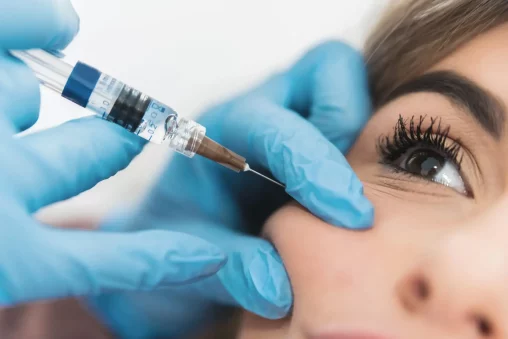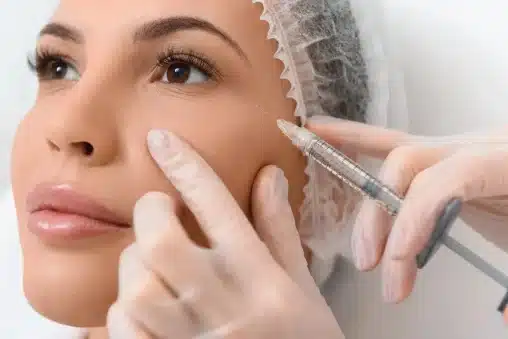Determining the “best” dermal filler for cheek lifting depends on individual patient needs, goals, and anatomy. While no single filler can universally claim the title, certain products excel in specific situations, offering tailored solutions for volume restoration, lifting, and contouring.
Advances in filler formulations now allow practitioners to choose options that balance immediate results with long-term benefits. We’ll explore the leading contenders, their unique properties, and how to identify the best match for cheek augmentation.
Best Fillers for Different Patient Profiles
The choice of filler depends on each patient’s goals, lifestyle, and anatomy. Below, we match specific fillers to different profiles, ensuring the right fit for their needs.
Temporary, Low-Risk Solutions
Hyaluronic Acid-Based Fillers, like Juvederm Voluma and Restylane Lyft, are ideal for patients looking for temporary, low-risk options. These fillers last between 12 to 24 months, allowing patients to adjust their treatment plan or explore other options later. Their reversibility with hyaluronidase adds a layer of safety, making them a top choice for first-time filler users or those concerned about potential complications.
However, the long-term effects of repeated filler treatments can lead to changes in the skin’s structure and response over time. This may require adjustments in dosage or treatment frequency to maintain natural, optimal results.
Significant Volume Loss
Calcium Hydroxylapatite (e.g., Radiesse) fillers provide immediate and substantial volume Patients with significant midface volume depletion may benefit from Radiesse. This calcium hydroxylapatite-based filler provides immediate volume and stimulates collagen production for longer-term benefits.
Its ability to improve skin firmness makes it a preferred choice for deep volumization. However, as a non-reversible filler, skilled application and thorough consultations are essential.
Long-Lasting, Natural Results
For gradual and natural enhancements, Sculptra offers exceptional benefits. By stimulating the body’s own collagen production, it delivers natural-looking results that evolve over time.
This is especially beneficial for patients with widespread volume loss or those aiming for subtle but impactful rejuvenation. Multiple sessions are typically required, making it a commitment for those seeking comprehensive improvement.
Criteria for an Effective Cheek Filler
Picking the right dermal filler for cheek lifting isn’t a one-size-fits-all process. Different dermal fillers for cheek enhancement depend on factors like longevity, lifting ability, and safety.
Longevity
How long a filler lasts plays a big role in its appeal. Hyaluronic acid fillers, like Juvederm and Restylane, generally provide results lasting between 12 to 24 months, depending on the product’s formulation and the treatment area. These fillers are ideal for patients who prefer a temporary solution or wish to adjust their treatment over time.
In contrast, calcium hydroxylapatite and poly-L-lactic acid fillers offer extended durability, often lasting up to two years or longer. These longer-lasting options cater to patients seeking more stable, low-maintenance results, though they require careful consideration due to their irreversible nature.
Lifting Capacity
A filler’s lifting ability depends on its thickness and adaptability. It depends largely on the filler’s viscosity—its thickness and ability to maintain structure—and elasticity, which determines how well it adapts to facial movements. High-viscosity fillers, such as Radiesse and Juvederm Voluma, excel in providing structural support for midface augmentation.
These fillers are designed to lift and contour without migrating, making them suitable for creating pronounced, natural-looking cheekbones. The ability to resist compression and maintain volume over time further enhances their effectiveness, ensuring a stable and aesthetically pleasing result.
Safety Profile
Safety is the top priority in any filler procedure. Common side effects include mild swelling, bruising, and tenderness, which typically resolve within a few days. However, rare but serious complications, such as vascular occlusion—a blockage of blood vessels—can occur if the filler is injected improperly.
Hyaluronic acid fillers offer a significant safety advantage due to their reversibility with hyaluronidase, providing an added layer of security for both patients and practitioners.
Non-reversible fillers demand precise application and a thorough understanding of facial anatomy to minimize risks. When considering options like Sculptra vs Radiesse, understanding their differences can help you make a better-informed decision for safe and effective results.
Patient-Specific Factors
Every patient has unique needs, and fillers must be selected accordingly. Factors such as skin quality, age, facial structure, and aesthetic goals must be thoroughly evaluated.
We’ll break down these considerations to help practitioners and patients make informed decisions.
Patient Age
Younger patients with supple skin and minimal volume loss often benefit most from hyaluronic acid (HA) fillers like Juvederm. These fillers provide subtle enhancements and allow for easy adjustments, making them ideal for individuals in their 20s or 30s who prioritize flexibility.
Older individuals, especially those with more pronounced volume depletion or skin laxity, may require collagen-stimulating options such as Sculptra. These fillers help rebuild the skin’s structure over time, offering a more comprehensive and lasting rejuvenation tailored to their needs.
Desired Outcome
Patients often weigh the trade-offs between temporary and permanent solutions when selecting a filler. Temporary fillers, like those based on hyaluronic acid, are ideal for individuals who value flexibility and may want to adjust their results over time. These fillers allow for incremental changes and reversibility, offering peace of mind to those new to dermal treatments.
In contrast, permanent options such as PMMA fillers cater to patients with well-defined, long-term aesthetic goals. These fillers provide enduring results but require careful planning and a clear understanding of the patient’s vision, as revisions can be more complex. Balancing these considerations ensures the chosen solution aligns with both immediate preferences and future needs.
Anatomical Considerations
Understanding of individual anatomical variations, including the zygomatic bone placement and facial fat distribution, is crucial for achieving balanced and symmetrical results.
High-viscosity fillers, such as Juvederm Voluma and Radiesse, are particularly effective for pronounced cheekbones, as they provide robust support and a lifting effect that complements strong midface features.
Conversely, softer fillers, like Restylane, are better suited for patients with delicate facial structures or thinner skin, ensuring a more natural result.
Practitioner Expertise
An experienced practitioner understands the complexities of facial anatomy, including the placement of blood vessels, muscle layers, and fat pads, which are critical for precise filler application.
Their expertise minimizes risks such as vascular occlusion and ensures a natural-looking result that aligns with the patient’s aesthetic goals. Additionally, seasoned injectors stay updated on the latest techniques and product advancements, allowing them to tailor treatments for optimal outcomes.
Understanding Dermal Fillers: What They Are and How They Work
Modern aesthetic treatments rely heavily on dermal fillers to combat the effects of aging. These injectable solutions restore lost volume and improve facial structure, helping patients achieve their aesthetic goals. This section dives into their function and why they’ve become essential tools in facial rejuvenation.
What Are Dermal Fillers?
Dermal fillers are injectable treatments designed to address volume loss, reshape contours, and reduce wrinkles. These advanced solutions mimic the skin’s natural composition, making them a seamless fit within the dermis. Their instant, minimally invasive nature has made them a staple for resolving a broad spectrum of cosmetic concerns.
Common Types of Dermal Fillers
The effectiveness of dermal fillers depends on understanding their unique properties. Different formulations are created to achieve specific aesthetic goals, from hydration to dramatic volume enhancement. Below, we explore the most commonly used fillers in the field.
Hyaluronic Acid (HA)
HA fillers are some of the most versatile options available today. They bind water molecules, enhancing hydration and elasticity while plumping the skin. Products like Juvederm and Restylane cater to diverse needs, from fine lines to midface volumization, with reversibility adding to their appeal.
Calcium Hydroxylapatite
Fillers made with calcium hydroxylapatite deliver immediate volume restoration and support. Their formulation mimics natural bone minerals, stimulating collagen production for improved skin firmness. Radiesse, a popular product in this category, is ideal for deeper volumization and structural enhancements.
Poly-L-lactic Acid
Poly-L-lactic acid fillers work differently, focusing on stimulating the body’s collagen production over time rather than providing immediate volume. Instead, they work by stimulating the body’s own collagen production over several months, resulting in a gradual yet long-lasting volumizing effect.
Sculptra, the leading product in this category, is often used for patients seeking a natural, progressive improvement in facial contours. These fillers are particularly suitable for individuals with widespread volume loss, as they rebuild the skin’s structure from within. However, achieving the desired results typically requires multiple treatment sessions, and the effects can last over two years. As they are not reversible, proper planning and consultation are essential.
Polymethylmethacrylate (PMMA)
PMMA fillers are designed for long-term results and provide significant structural support. These semi-permanent solutions, like Bellafill, combine collagen with microspheres to ensure durable effects. They work best for patients with defined goals who want lasting improvements.
How Do Fillers Work?
Each type of dermal filler interacts with the skin in a distinct way, depending on its composition. Hyaluronic acid (HA) fillers function by binding water molecules to instantly boost hydration and provide a visible plumpness that mimics youthful skin.
On the other hand, fillers like calcium hydroxylapatite and poly-L-lactic acid act by stimulating the body’s natural collagen production over time. This collagen regeneration not only creates structural support but also enhances the skin’s elasticity and firmness.
The result is a dual effect—a quick volumizing lift combined with gradual, lasting improvement in skin texture and tone. This multifaceted approach makes fillers especially effective for cheek lifting, catering to both immediate aesthetic enhancement and long-term rejuvenation.
Why Is Cheek Lifting Challenging?
Cheek lifting requires precision and a deep understanding of facial anatomy due to the midface’s complexity. Even small missteps can create noticeable imbalances.
High-viscosity fillers, such as Radiesse or Juvederm Voluma, are often chosen because they deliver targeted lift and contour without migrating from the injection site. This stability is crucial for maintaining natural facial dynamics.
Additionally, successful cheek augmentation depends heavily on the injector’s expertise. A thorough understanding of the underlying anatomy—including the zygomatic bone structure and fat pads—is essential to strategically place fillers.
Expert Insights and Clinical Studies
Recent studies provide valuable insights into the efficacy and safety of dermal fillers for cheek augmentation. The study “HA Filler Injection and Skin Quality” highlights how hyaluronic acid fillers enhance skin quality and recommends effective injection methods.
Another study, “Safety of Profhilo® from Postmarketing Data,” confirms the excellent safety profile of high- and low-molecular-weight hyaluronic acid fillers. These findings emphasize the importance of selecting the right filler and technique to meet patient goals while ensuring safety and lasting results.
Potential Risks and Considerations
While dermal fillers are generally considered safe when administered by trained professionals, it is essential to be aware of potential side effects and complications such as:
- Swelling, redness, and tenderness at the injection site.
- Temporary bruising.
- Vascular occlusion: A blockage of blood vessels requiring immediate intervention.
- Granulomas: Small lumps due to filler clumping or immune reactions.
Conclusion
While no universal “best” filler exists for cheek lifting, understanding the unique properties of each option is essential for achieving desired results. The choice should be guided by patient-specific factors, the filler’s attributes, and the expertise of the practitioner. For optimal outcomes, consult a qualified professional who can tailor treatments to your unique aesthetic goals.
References
Cassuto D, Delledonne M, Zaccaria G, Illiano I, Giori AM, Bellia G. Safety Assessment of High- and Low-Molecular-Weight Hyaluronans (Profhilo®) as Derived from Worldwide Postmarketing Data. Biomed Res Int. 2020 Jun 20;2020:8159047. doi: 10.1155/2020/8159047. PMID: 32685528; PMCID: PMC7327616.
Peng JH, Peng PH. HA Filler Injection and Skin Quality-Literature Minireview and Injection Techniques. Indian J Plast Surg. 2020 Aug;53(2):198-206. doi: 10.1055/s-0040-1715545. Epub 2020 Aug 29. PMID: 32884186; PMCID: PMC7458846.
Bravo B, Correia P, Gonçalves Junior JE, Sant’Anna B, Kerob D. Benefits of topical hyaluronic acid for skin quality and signs of skin aging: From literature review to clinical evidence. Dermatol Ther. 2022 Dec;35(12):e15903. doi: 10.1111/dth.15903. Epub 2022 Oct 21. PMID: 36200921; PMCID: PMC10078143.



0 Comments